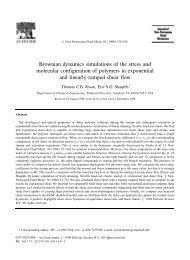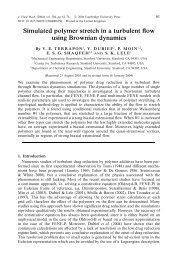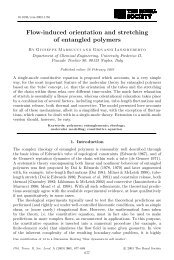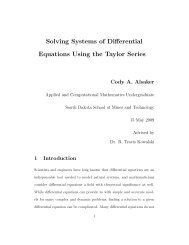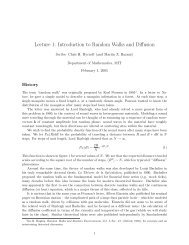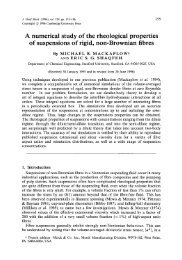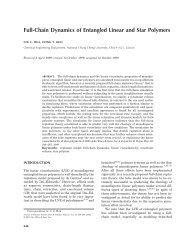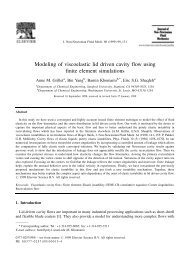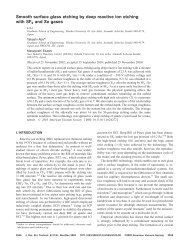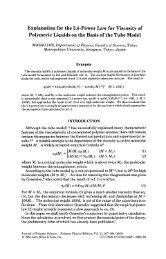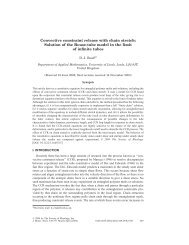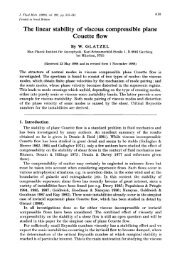Molecular modelling of entangled polymer fluids under flow The ...
Molecular modelling of entangled polymer fluids under flow The ...
Molecular modelling of entangled polymer fluids under flow The ...
Create successful ePaper yourself
Turn your PDF publications into a flip-book with our unique Google optimized e-Paper software.
40 CHAPTER 2. INTRODUCTION TO MOLECULAR RHEOLOGY<br />
I now present a brief outline <strong>of</strong> the drag-strain coupling modification to the pompom<br />
equations suggested by Blackwell et al. (2000). <strong>The</strong> purpose <strong>of</strong> this modification is<br />
to incorporate the physical effect <strong>of</strong> the branch points withdrawing in to the backbone<br />
tube before the maximum stretch condition is reached. <strong>The</strong> effect <strong>of</strong> this modification<br />
is to smooth out the discontinuity in the gradient <strong>of</strong> the stress which is predicted by<br />
the original model when the maximum stretch is reached. This discontinuity is not<br />
seen in experimental data for mono-disperse H-<strong>polymer</strong>s [McLeish et al. (1999)]. <strong>The</strong><br />
effect <strong>of</strong> withdrawal <strong>of</strong> the branch-point into the backbone tube before the onset <strong>of</strong><br />
maximum stretch is modelled by coupling it to the tension in the backbone through<br />
the backbone stretch, λ. This withdrawal shortens the effective length <strong>of</strong> the free arms<br />
since some <strong>of</strong> the arm material is now inside the tube. <strong>The</strong> average time taken for a<br />
free arm to retract up to the branch point is exponentially dependent on arm length,<br />
which in turn determines how frequently the branch point can take a diffusive step.<br />
Hence even a small degree <strong>of</strong> branch point withdrawal has a strong influence on the<br />
stretch relaxation time. By allowing the branch point to move in a harmonic potential<br />
the variation <strong>of</strong> stretch relaxation can be related to the value <strong>of</strong> the backbone stretch.<br />
This results in a modification <strong>of</strong> the stretch relaxation time as shown in table 2.2. <strong>The</strong><br />
stretch relaxation time, which was constant in the original model, has a dependence on<br />
the backbone stretch.<br />
τ s → τ s e −ν∗ (λ−1) . (2.42)<br />
Where ν ∗ is a constant which is inversely proportional to the co-efficient <strong>of</strong> the harmonic<br />
potential in which the branch point moves. Hence as the stretch grows, the<br />
branch points become increasingly withdrawn producing exponentially faster stretch<br />
relaxation. Thus as the maximum stretch is approached the molecule is able to relax<br />
its stretch faster and so the growth rate <strong>of</strong> λ is reduced. <strong>The</strong> constant ν ∗ is expected<br />
to be inversely proportional to q since increased branching will increase the localisation<br />
<strong>of</strong> the branch points. For the multi-mode approach (see section 2.5.3) Blackwell et al.<br />
(2000) found that a material independent value <strong>of</strong> ν ∗ = 2/q was consistent with existing<br />
data.<br />
<strong>The</strong> pom-pom model has been tested against experimental data on model H <strong>polymer</strong>s<br />
[McLeish et al. (1999)]. This study included both linear and non-linear rheology<br />
as well as SANS measurements <strong>under</strong> strong <strong>flow</strong>. <strong>The</strong> quantitative comparison is very<br />
reasonable. However, the availability <strong>of</strong> data on model H and pom-pom <strong>polymer</strong>s is<br />
limited.<br />
2.5.3 Randomly branched <strong>polymer</strong>s<br />
<strong>The</strong> pom-pom equations can be generalised from mono-disperse melts <strong>of</strong> pom-pom<br />
molecules to model the rheology <strong>of</strong> industrial grade <strong>polymer</strong>ic materials such as low



